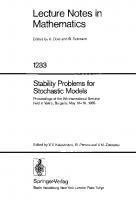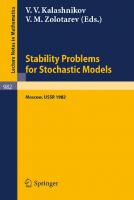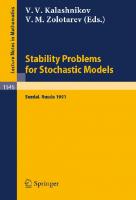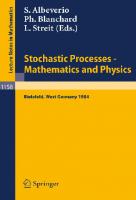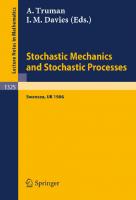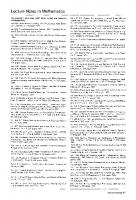Stochastic Analysis: Proceedings of the Japanese-French Seminar held in Paris, France, June 16-19, 1987 (Lecture Notes in Mathematics, 1322) 3540193529, 9783540193524
139 37 12MB
English Pages 212 [206] Year 1988
Recommend Papers
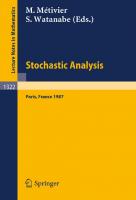
- Author / Uploaded
- Michel Metivier (editor)
- Shinzo Watanabe (editor)
File loading please wait...
Citation preview
Lecture Notes in Mathematics Edited by A. Dold and B. Eckmann
1322 M. Metivier S. Watanabe (Eds.)
Stochastic Analysis Proceedings of the Japanese-French Seminar held in Paris, France, June 16-19, 1987
Springer-Verlag Berlin Heidelberg New York London Paris Tokyo
Editors
Michel Metivier Departernent de Mathematiques Appliquees Ecole Polytechnique 91128 Palaiseau, France Shinzo Watanabe Department of Mathematics, Faculty of Science Kyoto University, Kyoto, 606 Japan
Mathematics Subject Classification (1980): 60F, 60G, 60H, 60J ISBN 3-540-19352-9 Springer-Verlag Berlin Heidelberg New York ISBN 0-387-19352-9 Springer-Verlag New York Berlin Heidelberg
This work is subject to copyright. All rights are reserved, whether the whole or part of the material is concerned, specifically the rights of translation, reprinting, re-use of illustrations, recitation, broadcasting, reproduction on microfilms or in other ways, and storage in data banks. Duplication of this publication or parts thereof is only permitted under the provisions of the German Copyright Law of September 9, 1965, in its version of June 24, 1985, and a copyright fee must always be paid. Violations fall under the prosecution act of the German Copyright Law.
© Springer-Verlag Berlin Heidelberg 1988 Printed in Germany Printing and binding: Druckhaus Beltz, Hemsbach/Bergstr. 2146/3140-543210
PREFACE
As a project under the France-Japan Cooperative Science Program sponsored by C.N.R.S. (Centre National de la Recherche Scientifique) and J.S.P.S. (Japan Society for the Promotion of Science), a joint seminar on probability theory was held June 16-19, 1987, at Ecole Normale Superieure, Paris. The main theme was stochastic analysis and applications to large scale systems. Nineteen lectures were presented on various topics like the Malliavin calculus, infinite dimensional stochastic differential equations and stochastic partial differential equations, limit theorems for particle systems, diffusions in random environment, hydrodynamical models, etc. This volume of the Springer Lecture Notes is devoted to the original papers presented by the participants. A few lectures given at the seminar correspond to papers already published or being published elsewhere and are therefore absent from this volume. Because of the variety of the problems studied in those lectures, we did not find proper to try to group them -rather artificially- by topics, and adopted the alphabetic order of authors. We would express our sincere thanks to contributors of this volume, all the participants of the seminar and also to Professor T. Hida who could not participate but, without whose kind advice and suggestions, this seminar could not have been realized. It is also our pleasure to give our appreciation to Springer-Verlag for the prompt and efficient publication of the volume and Mrs Jeanne Bailleul for her help in the organization of the meeting and the preparation of the final volume.
February 5, 1988 Michel METIVIER - Shinzo WATANABE
TABLE OF CONTENTS G. BENAROUS Noyau de la chaleur hypoelliptique et geometrie sous-riemannienne M. FUKUSHIMA On two classes of smooth measures for symmetric Markov processes
17
T. FUNAKI The hydrodynamical limit for scalar Ginzburg-Landau model on R
28
N. IKEDA, S. KUSUOKA Short time asymptotics for fundamental solutions of diffusion equations
37
K. ITO
Malliavin calculus on a Segal space
50
Y. KASAHARA, M. MAEJIMA Weak convergence of functionals of point processes on Rd
73
Y. KATZNELSON, P. MALLIAVIN Image des points critiques d'une application reguliere
85
S. KUSUOKA Degree theorem in certain Wiener Riemannian manifolds
93
R. LEANDRE Applications quantitatives et geometriques du calcul de Malliavin
109
Y. LE JAN On the Fock space representation of occupations times for non reversible Markov processes
134
M. METIVIER, M. VIOT On weak solutions of stochastic partial differential equations
139
P.A. MEYER remarque sur les chaos de Wiener
151
H. TANAKA Limit theorem for one-dimensional diffusion process in Brownian environment
156
H. UEMURA, S. WATANABE Diffusion processes and heat kernels on certain nilpotent groups
173
LIST OF PARTICIPANTS
D. BAKRY
Universite Louis Pasteur, UER de Mathematiques 7, rue Rene Descartes. 67084 Strasbourg Cedex (France)
G. BEN AROUS
Centre de Mathematiques Appliquees. Ecole Normale Superieure 45, rue d'Ulm. 75230 Paris Cedex 05 (France)
J.-M. BISMUT
UER 3e Cycle de Mathematiques. Universite de Paris Sud Batiment 425. 91405 Orsay Cedex (France)
M. CHALEYAT-MAUREL Laboratoire de Probabilites. Tour 56. Universite de Paris VI 4, place Jussieu. 75252 Paris Cedex 05 (France) N. EL KAROUI
Laboratoire de Probabilites. Tour 56. Universite de Paris VI 4, place Jussieu. 75252 Paris Cedex 05 (France)
M. FUKUSHIMA
Department of Mathematics. College of General Education. Osaka University, Toyonaka, Osaka, 560 (Japan)
T. FUNAKI
Department of Mathematics. Faculty of Science. Nagoya University, Nagoya, 464 (Japan)
B. GAVEAU
UER 47. Laboratoire Analyse Complexe et Geometrie. Tour 45-46. Universite Paris VI. 4, pl. Jussieu. 75252 Paris Cx 05 (France)
N. IKEDA
Department of Mathematics. Faculty of Science Osaka University, Toyonaka, Osaka, 560 (Japan)
K. ITO
RIMS, Kyoto University, Kyoto, 606 (Japan)
J. JACOD
Laboratoire de Probabilites. Tour 56. Universite de Paris VI 4, place Jussieu. 75252 Paris Cedex 05 (France)
Y. KASAHARA
Institute of Mathematics. University of Tsukuba. Sakuramura. Ibaraki 305 (Japan)
C. KIPNIS
Centre de Mathematiques Appliquees. Ecole Polytechnique. 91128 Palaiseau Cedex (France)
S. KUSUOKA
RIMS. University of Kyoto, Kyoto, 606 (Japan)
R. LEANDRE
Departement de Mathematiques. Faculte des Sciences de Besancon 25030 Besancon Cedex (France)
Y. LE JAN
Laboratoire de Probabilites. Tour 56. Universite de Paris VI 4, place Jussieu. 75252 Paris Cedex 05 (France)
P. MALLIAVIN
10, rue Saint-Louis-en-l'lle. 75004 Paris (France)
M. METIVIER
Centre de Mathematiques Appliquees. Ecole Polytechnique 91128 Palaiseau Cedex (France)
P.-A. MEYER
Institut de Recherche Mathematique Avancee. Rue du General Zimmer. 67084 Strasbourg Cedex (France)
J. NEVEU
Laboratoire de Probabilites. Tour 56. Universite de Paris VI 4, place Jussieu. 75252 Paris Cedex 05 (France)
A.-S. SZNITMAN
Courant Institute of Mathematical Sciences. New York University 251 Mercer Street. New York. N. Y. 10012 (U.S.A.)
H. TANAKA
Department of Mathematics. Faculty of Science and Technology Keio University, Yokohama, 223 (Japan)
S. WATANABE
Department of Mathematics. Faculty of Science Kyoto University. Kyoto, 606 (Japan)
TITLES OF LECTURES WHICH HAVE BEEN PUBLISHED SEPARATELY C. KIPNIS and S. OLlA Large deviations from the hydrodynamical limit for a system of independent Brownian particles. J. NEVEU Multiplicative martingales for spatial branching processes. A.-S. SZNITMAN Propagation of chaos for annihilating Brownian spheres.
NOYAU DE LA CHALEUR HYPOELLIPTlQUE ET GEOMETRIE SOUS-RIEMANNIENNE Gerard BEN AROUS Centre de Mathematiques Appliquees. Ecole Normale Superieure 45, rue d'Ulm. 75230 Paris Cedex 05 (France)
I. INTRODOCTION
Nous allons decr'Lre dans cet article les principaux resultats connus sur Le COIlpJrtement asyrrptotique du noyau de la chaleur aesoci.e a un operaceur elliptique degenere, illustrer les principaux phenomenes par des exemples et poser quelques probrerres encore ouverts.
Dans la suite, on consaderera L'operateur L
l!!
1
-2 L:lC+X i=l J. 0
aU les
Xi
(1.l)
sont des champs de vecteurs
Cb
00
d sur JR
On fera toujours l' hypothese de Hormander forte
Lie (Xl .. , X (x) = JRd m)
Vx E JRd
(1.2)
d - L et L sont hypoelliptiques. t Ie noyau de la chaleur associe a L, c'est-a-dire la solution
qui assure que les opezateurs
Soit alors
Pt(x,y)
fondarrentale de sociee a
L
dt - L , ou encore la densite de la loi de la diffusion
issue de
x.
x t (x)
as-
cette diffusion est donnee par la solution de l' equation stochastique prise au sens de Stratonovitch :
dxt(x}
1
(1.3) Xo(X} = x ,
ou
designe un rrouvement brCMlien m-d.i.mensionnel.
Nous voulons etudier ici Le o::mportement asymptotique de
P (x,y) lorsque t tend t vers zero, ou encore Ie comportement asymptotique, lorsque E tend vers zero, de (x,y)
ou
(x,y)
est la densi.t.e de la loi de la solution
E
xo(x) = x . En effet, par scaling evident, on a
(x)
de:
(1.4)
2
Nous noterons
If! , h
H1
nulles en
definie par
rn
= L
i=l
I' espace des fonctions
0 • Nous noterons
x
I
et
x
a valeurs
[ 0 , 1]
sur H1
et
dans
la nome de
lhl ,
JRd , I' application (h)
!!)x
qui,
a un
element
h
de
H1
de I' equation :
1=1
(1.6)
x • 1
On dira que
Pour
L2 h
(1.5)
i'f)x
o
derivees
r1
associe la solution
=
a
la derivee de
Jo
Considerons alors, pour
=
h
est une courbe horizontale issue de
..,x(H )
y
dans JRd r consf.derons Le sous-ensemble
KY
x
x
de
1:j1
defini par : (1. 7)
Par L'Irypothese (1.2), cet ensemble est non vide
on def'Lnf.t; alors la distance sous-
riemannienne (ou de Camot - Cara'thecdory) par :
L'infimum est atteint dans (1.8) et
d
defIrri t; une distance continue sur JRd
x
JRd
(c.6. [8], p. 33). 5i
Lest elliptique, cette distance ooincide avec la distance riemannienne asso-
a
ciee
la metrique riemannienne definie par l'inverse du syrnbole principal de
Rappelons qu'alors
L
2L.
s'ecrit:
1
L="2.6.+X au
.6.
(1.9)
est L'operareur de Laplace - Beltrami pour cette metrique et
X un charep de
vecteur. Le premier pas dans l'etude asynptotique de
pt(x,y)
a ete fait par Leandre ([13])
et generalise Le resultat de Varadhan [19] relatif au cas elliptique :
THEoREME
1.10.- Avec .tv>
lim t log P (x,y)
t
pllec.edentv>, on a : 1 d 2( x,y) -"2
Re.mMqu.e. 1.11.- Ce resultat pourrait etre obtenu de facon purernent analytique en utilisant la technique introduite par KannaI [Ll ] dans Le cas elliptique. C'est alors un resultat sur la vitesse de propagation des andes pour L'operateur
- L
3 II. DEvEwPPEMENT ASYMP'IOTIQUE DU NOYAU DE I.A CHALEUR HORS DU CUT-:r.J:aJS
1. Ie cut-locus sous-riernannien Nous allons ici donner Le =nporternent asyrnptotique precis du noyau de la chaleur
Pt (x,y)
pour les "bons points"
(x,y) , L,e , les points hors du cut-locus.
Conmencons par definir cette notion de cut-locus qui generalise la notion correspon-
dante dans Ie cas riemannien et qui a ete introduite par Bismut [8]. Cons.Iderons Le hami1tonien
1
m
H assocf.e a. L, sur Le cotangent de :JRd
H(x,p) = -2 :E i=l
2
pour
d
(x,p) E T*:JR
(2.1)
et notons l!J (x,p) Le flot hami1tonien assocte a. H issu de t projection de T*:JRd sur :JRd DEFINITION (2.2).- Soie.n;t x
e.:t y
peu dans te. cu.:t- toeUlo s i. et:
!.> e.u.£.e.IIJe.n;t
(x,p) ,et
deux point/o de. :JRd , te. coup£.e.
la
rt
n'
